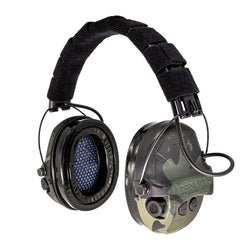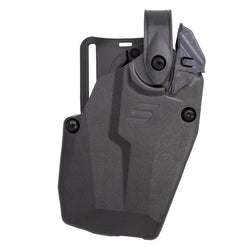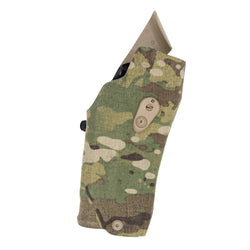Investing in a quality weaponlight for your handgun is kind of a big deal. In my opinion, it’s just about as important of a decision as selecting your first firearm, but that’s a whole ‘nother can of worms.
A weaponlight is a necessary piece of equipment, aiding in your ability to positively identify targets (determine friend from foe) in low-light situations and increase the likelihood of successfully stopping a threat in civilian concealed carry, duty, or tactical shooting applications.
And because it’s a big deal, it’s important to understand that not all weaponlights are created equal. There are tons of options out there, varying widely in terms of light output, beam strength, and overall quality, too.
In this detailed guide, written by a guy who has a minor obsession with shiny objects, we’ll walk through the important considerations for choosing the right weaponlight for you and your handgun, knowing full well that there is not one universally perfect solution and that needs vary greatly from one shooter to another.
Without further ado, let’s dive right in.
Determining the Right weaponLight
Choosing the right weaponlight is a bit of a science, and what works for one person might not be ideal for another, depending on factors such as the size of your handgun, your specific use case (concealed carry, duty, etc.), your budget, and so on. That said, though, it’s important to understand some specific weaponlight features and what they mean.

Lumens and Candela: Brightness and Beam Strength
When selecting a weaponlight, you’ll want to take note of its brightness, measured in lumens, and the overall beam strength, measured in candelas. The higher the lumen and candela output, the more powerful the light is.
So, if you’re planning to use a weaponlight primarily for home defense applications, you’ll want something bright enough to illuminate a room without blinding yourself. I typically stick to lights with a maximum output between 300 and 800 lumens for home defense applications, which gives me plenty of light to identify targets without having to worry about overwhelming my tired eyes in the middle of the night.
Alternatively, if you’re looking for a weaponlight for your duty gun where the beam needs to be brighter at greater distances, you will want to purchase a light with a much higher output (think 800-1,000+ lumens). Obviously, this is a very oversimplified explanation, but you get the point.
Size and Compatibility
The size and compatibility of your weaponlight are just as important as its brightness. You need to find a model that works with your specific needs while maintaining its balance and usability.

For a subcompact handgun, like a Springfield Hellcat or Sig Sauer P365, you’ll want to steer clear of big, bulky light models. Imagine a big, full-size light hanging off the end of your gun. Not only does it look a little silly, but that bigger light will also weigh you down a bit and might even create a bit of a snag hazard. Instead, a more compact weaponlight model will be lighter and more streamlined, making your gun easier to handle overall.
On the other hand, if you’re using a full-sized handgun, like my trusty Walther Q5 Match (it’s a great race gun but an even better home defense rig), you’ll have a lot more flexibility when it comes to the size and profile of the light.
Larger weaponlights can fit comfortably on full-size handguns and typically offer higher lumen/candela outputs. However, those larger lights are also heavier. Even with a full-size handgun, make sure that your weaponlight won’t negatively affect the balance of your firearm or inhibit your ability to draw and present the gun on target.

I’ll add that while most modern handguns feature some sort of accessory rail, not all of them are created equal, so it’s a good idea to pay attention to the mounting requirements of your chosen weaponlight to make sure it will work with your specific firearm.
There’s nothing more infuriating than purchasing an accessory for your new gun and finding out it’s not compatible. Imagine dropping $100 or more on the newest rail-mounted, full-size weaponlight and realizing you needed a guard-mounted light or something more compact. Not fun.
But don’t fret. Most of the time, all the information you need, including output and mounting compatibility, should be available on a manufacturer’s website or the product packaging, at the very least.
Modes and Features
Modern technology is great. When it comes to weaponlights (as well as optics, laser sights, and other trinkets), we’re spoiled with endless options and multiple modes of operation. That said, even the most basic of weaponlights will likely be more than just a simple on/off tool. Most weaponlights will offer varying output modes (i.e., high, medium, and low), or user-selectable operational modes. Some light models also have built-in laser sights with even more operational modes.
This added versatility is great, but the more functions and features you have to think about, the more complicated things can get when trying to make a purchasing decision. You might find that some lights offer momentary and constant-on functionality while others might feature strobe modes that disorient would-be threats, laser+light modes, and infrared modes, among others.
There are seemingly endless options out there. As such, I highly advise that you determine how you plan to use the light (home defense, duty, tac-ops, etc.) before you start shopping for weaponlights, then narrow and refine your search based on applicable functionality and mode features.
Clear as mud, right? In short, don’t buy the flashiest weaponlight you find just because it’s packed to the gills with features. Instead, focus on finding a quality light that has the right features and functionality for the task at hand, whatever that may be.
Practical Considerations for Weaponlights
In addition to the techy stuff, you’ll want to consider the practicality of a given light system in the real world. This will help determine what’s quality and what’s just another cheap gimmick that’ll leave you high and dry when you need it most.
Ease of Operation
There’s really no other way to say it: weaponlights should be easy to use.
In a high-stress situation, you need to be able to operate your light without trying to remember some complicated schematic from the user manual or find some small, hidden tab somewhere to activate it. Instead, you need to be able to operate your weaponlight quickly and effectively with one hand.
Having learned this the hard way, I’d highly encourage you to take a hard look at the controls of a given weaponlight, no matter what you plan to use it for. Are they ambidextrous and easy to find? Can you operate the light with one hand without altering your shooting grip?
Learn all you can about a given weaponlight before you purchase it. You should also consider how easily you can toggle between different modes.

Further, consider the type of battery a given weaponlight uses and be sure to check its estimated battery life. Steer clear of cheap lights that use obscure and hard-to-find batteries or those that are going to nickel and dime you to death by going through hundreds of single-use batteries due to poor battery life.
There are tons of high-quality options out there that operate on rechargeable batteries or, at the very least, common and easy-to-find batteries, like AAAs and CR123s, with reliable, long-lasting battery life. Focus on those and thank me later.
Weaponlight Quality and Trustworthiness
Don’t skimp out on quality in favor of a low-cost light you find on Amazon. Just don’t. While it might be tempting to go for a budget-friendly option, especially if you’re just scratching the surface of weaponlights and aren’t really sure what you need, there’s a clear difference between the high-end brands and those cheaper, foreign-made alternatives.
In my honest opinion, you can’t go wrong with Nightstick, Streamlight, and SureFire weaponlights. Each of these manufacturers is known for producing quality and reliable weaponlight systems designed to withstand just about anything you can throw at them in high-stress situations, all without breaking the bank.
I’ve nothing but positive things to say about these manufacturers, though I have a bit of a bias toward Nightstick for personal reasons. As a law enforcement spouse, I count on Nightstick products to bring my wife home safely, which is a testament in itself to the quality (and reputation) of Nightstick’s products. Obviously, that’s just my personal bias, but you get my point: Reputation matters.
On the other hand, budget-priced weaponlights are often cheaper for a reason. While they may look similar to big-name products, these low-cost lights typically have terrible battery life, poorly insulated electronics (which can pose a safety hazard), and questionable durability and consistency.
A Final Word on Weaponlights
The short and sweet of it is that there’s no one “right” answer when looking for a weaponlight. There are several important factors to consider before making a purchase, including maximum outputs, modes and features, weapon size and platform, and application.
Ultimately, the best weaponlight is one that is suitable for your firearm and your needs. That said, there is one universal truth regarding weaponlights: quality matters more than price. Never skimp on quality to save a few bucks. The so-called “cost savings” just aren’t worth it in the long run.
When shopping for a weaponlight, take your time and don’t pull the trigger on the first and flashiest light you find. Test different models (or, at least read up on the features if shopping online), and don’t forget to practice regularly to ensure you’re fully comfortable with the operation (and added weight) so you’re always prepared for the worst.
Above all else, enjoy the shopping experience; there are endless options to choose from. Just don’t rush it, or you might end up with a flashlight that’s more “trash” than “flash.” Get out there and find what’s right for you.











